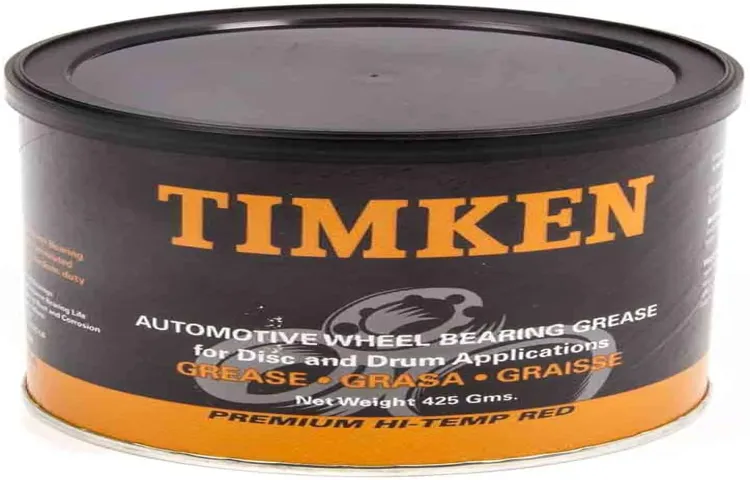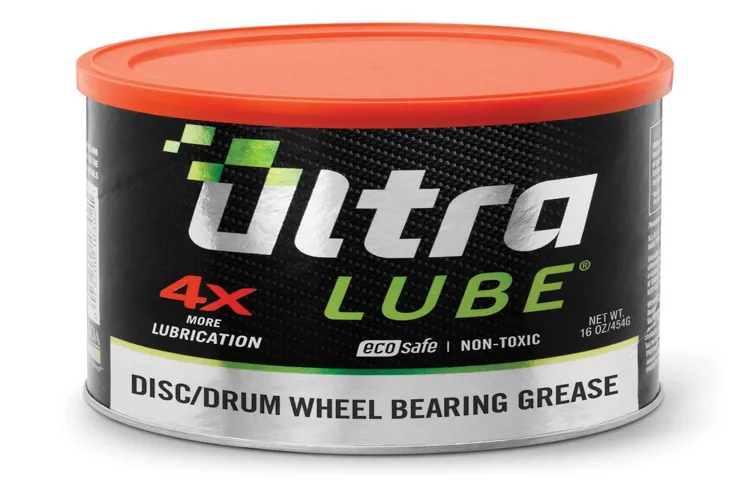Have you ever experienced a strange noise coming from your car’s wheels? Or maybe a wobbling sensation that seems to be getting worse? One possible cause for these symptoms could be worn-out or damaged wheel bearings. But what is a wheel bearing, and why does it need grease? Simply put, a wheel bearing is a metal ring that allows the wheel to spin freely on the axle. It relies on a special type of lubricant called wheel bearing grease to reduce friction, heat, and wear.
In this blog post, we’ll dive deeper into the topic of wheel bearing grease and what you need to know to keep your car’s bearings healthy.
Table of Contents
What is Wheel Bearing Grease?
“What is wheel bearing grease?” is a common question among vehicle owners. Simply put, wheel bearing grease is a type of lubricant that is used in the bearings of your vehicle’s wheels. It helps to reduce friction between the metal surfaces of the bearings, allowing them to move smoothly.
Wheel bearing grease is a thick, viscous substance that is made up of a base oil and a variety of additives. It is specifically designed to withstand the high temperatures and pressures that occur within the wheel bearings. Using the proper wheel bearing grease is crucial for keeping your wheels in working order and preventing damage or failure.
It is recommended to have your wheel bearing grease replaced every 30,000 miles or during your regular vehicle maintenance appointments to ensure optimal performance.
Definition of Wheel Bearing Grease
Wheel bearing grease is a specialized lubricant that is used to reduce friction between the wheel bearings and the hub assembly in vehicles. It is a thick grease that is designed to withstand the high temperatures and pressures that are created by the rolling wheels. The main purpose of wheel bearing grease is to protect the bearings from wear and tear, reduce friction between moving parts, and prevent rust and corrosion.
When it comes to choosing the right wheel bearing grease, it is important to consider the type of vehicle you are using and the type of wheel bearings installed. It is also essential to make sure that the grease you choose meets the manufacturer’s specifications. By regularly lubricating your wheel bearings with the right grease, you can extend the life of your vehicle’s components, ensure smoother and safer driving, and avoid costly repairs in the long run.

Importance of Grease in Wheel Bearings
Wheel bearing grease is a lubricant that is essential to the proper functioning of your vehicle’s wheel bearings. It is a viscous substance made up of oil and a thickening agent, typically lithium-based. Wheel bearing grease helps to reduce friction and wear on the bearings, which can ultimately lead to their failure if not properly maintained.
This is because the wheel bearings in your vehicle are constantly subjected to high pressures and heat, which can cause them to wear down over time. Properly lubricated bearings can also help to protect against corrosion and other types of damage. Therefore, it is important to use the right type of wheel bearing grease for your vehicle and to keep your bearings properly lubricated to maintain their longevity and functionality.
Types of Wheel Bearing Grease
Wheel bearing grease is an essential component of any vehicle’s wheel system as it helps to lubricate the bearings. There are two types of wheel bearing grease available, namely conventional and synthetic. Conventional grease is generally made of mineral oil and a thickening agent, such as lithium.
It can handle high temperatures and pressures and is perfect for vehicles that have standard bearings. On the other hand, synthetic grease is made using synthetic oil and a thickening agent, such as polyurea. This kind of grease is more durable and can handle extreme temperature changes, making it ideal for vehicles used in high-performance situations.
When choosing the right type of grease for your car’s wheel bearings, it’s crucial to consider factors like driving conditions, the type of vehicle, and the frequency of use. Always consult a professional mechanic or read the owner’s manual before making any decisions to ensure the correct type of grease is selected.
Differentiating Between Grease Types
When it comes to wheel bearing grease, there are three main types to consider: lithium complex, calcium sulfonate, and polyurea. Each type has its own unique properties and is best suited for specific applications. Lithium complex grease, for example, is a general-purpose grease that is commonly used in automotive and industrial applications.
It offers good water resistance and can withstand high temperatures. Calcium sulfonate grease, on the other hand, is ideal for heavy-duty applications, such as mining and construction. It has excellent corrosion resistance and can withstand extreme pressures.
Finally, polyurea grease is a high-performance grease that is commonly used in electric motors and other applications where high speeds and temperatures are expected. It offers excellent water resistance and is ideal for use in harsh environments. Ultimately, choosing the right type of wheel bearing grease depends on the specific needs of the application.
By understanding the unique properties of each type, it is possible to make an informed decision that will ensure optimum performance and longevity.
Pros and Cons of Each Type
When it comes to choosing the right wheel bearing grease, there are various types available on the market, each with its own set of pros and cons. One common type is lithium-based grease, which is a popular choice due to its excellent water resistance and high-temperature tolerance. However, it can harden over time and may not be the best option for low-temperature environments.
Another type is molybdenum disulfide (moly) grease, which is great for high-pressure applications due to its ability to withstand heavy loads. However, it can attract dirt and grime, leading to potential contamination issues. Calcium-based grease is another option, known for its excellent corrosion resistance and high-density consistency, but it can be difficult to apply evenly.
Ultimately, the type of wheel bearing grease you choose will depend on your specific needs and the conditions you operate in. It’s important to consider each type’s advantages and disadvantages before making a decision.
Choosing the Right Type for Your Vehicle
When choosing the right type of wheel bearing grease for your vehicle, there are a few different options to consider. The two most common types are lithium and synthetic greases. Lithium grease is a versatile option that can work well in most conditions, while synthetic grease is formulated to perform better in extreme temperatures and high-pressure environments.
Additionally, there are also specialty greases such as ceramic and marine grease that are specifically designed for certain applications. It’s important to consult your vehicle’s owner manual and consider the conditions in which you drive before selecting the right type of grease. By doing so, you can help ensure that your wheel bearings are properly lubricated and your vehicle performs optimally on the road.
How to Apply Wheel Bearing Grease?
Wheel bearing grease is a lubricant used to reduce the friction between the wheel bearings and the wheel hub. Applying grease to your wheel bearings is important to keep them running smoothly and prevent damage to your car’s suspension system. To apply wheel bearing grease, you need to first remove the wheel from the axle and brake assembly.
Then clean the bearing with a degreaser or solvent to remove any dirt or grime. Next, fill the gap between the bearing and the hub with a small amount of grease. To ensure even distribution, rotate the bearing while applying the grease.
Finally, put the wheel back on the axle and torque it to the manufacturer’s specifications. Remember to always use the appropriate grease recommended by your car’s manufacturer and do not overfill or underfill the bearing.
Tools Required for Grease Application
If you want your bearings to last the distance, applying grease is essential. To start, you’ll need a few tools: a grease gun, a set of bearing packers, and a supply of high-quality grease. Before you begin, make sure everything is clean and free of debris.
Locate the grease fittings on your bearings and attach the grease gun. Slowly pump a small amount of grease into the bearings until you see it start to seep out from around the seals. Once this happens, move to the next fitting and continue the process until you’ve applied grease to all your bearings.
If you’re using a bearing packer, simply place the bearings in the packer, apply some grease and slowly press the plunger down to push the grease into the bearings. It’s important not to overpack the bearings, as this can cause them to overheat and fail. With regular maintenance and proper grease application, your bearings will last longer and perform better, giving you a safer, more reliable ride on the road.
So, keep your bearings in tip-top shape and take care of them with the right tools and techniques.
Step-by-Step Guide to Applying Grease
When it comes to maintaining your vehicle, applying wheel bearing grease is an essential task that should never be skipped. This is because it helps to reduce heat, friction, and wear, which can all negatively impact the performance and longevity of your bearings. So, if you’re wondering how to apply wheel bearing grease, here’s a simple guide to follow.
Firstly, start by cleaning the bearings to remove any dirt and debris. This can be done using a solvent or degreaser and a clean rag. Once the bearings are clean, you can move on to the next step.
Next, apply a small amount of grease to the palm of your hand and coat the bearings evenly. It’s important not to over-grease, as this can cause excess buildup and lead to problems. After that, carefully place the bearings back into the wheel hub and install any necessary components.
Once all components are in place, you can then add more grease on the outside of the bearing. Finally, spin the wheel to distribute the grease evenly and ensure that everything is working smoothly. Overall, applying wheel bearing grease may seem like a daunting task, but with some basic knowledge and a little bit of practice, it’s actually quite easy to do.
Just remember to clean the bearings first, be mindful of how much grease you use, and ensure that everything is properly installed and lubricated. By taking care of your bearings in this way, you’ll be helping to extend the life of your vehicle and ensuring that it runs smoothly for years to come.
When to Replace Wheel Bearing Grease?
Wheel bearing grease is a lubricating material used to reduce friction and wear in the wheel bearings of a vehicle. It is often made of a mixture of oil and a thickening agent, such as lithium, and is designed to withstand high heat and pressure. While wheel bearing grease is known for its longevity, it can break down over time, leading to decreased performance and potential damage to the bearings.
Therefore, it is essential to replace the wheel bearing grease periodically to ensure the proper functioning of the wheel bearings. The ideal replacement schedule for wheel bearing grease can vary depending on the manufacturer’s recommendations and the type of vehicle. However, a general rule of thumb is to replace the grease every 30,000 miles or every two years, whichever comes first.
Regular maintenance, including greasing the wheel bearings, can help extend the life of the bearings and prevent costly repairs down the road. So if you notice any decrease in performance or unusual sounds coming from your vehicle’s wheels, it may be time to check and replace the wheel bearing grease.
Conclusion
In conclusion, wheel bearing grease is the magical elixir that keeps your wheels spinning smoothly and quietly. Much like the engine oil is the lifeblood of your car’s engine, wheel bearing grease is the guardian angel of your car’s wheels. It’s a thick and viscous substance that is specially formulated to withstand extreme temperatures and pressures and provide long-lasting protection against wear and tear.
So, if you want to keep your car running like a well-oiled machine, don’t skimp on the grease! It may not be the most glamorous part of car maintenance, but it’s certainly one of the most important. After all, without grease, your wheels would be screeching like banshees and your car would be headed straight for the scrapyard. So, let’s give a round of applause to wheel bearing grease, the unsung hero of automotive lubrication!”
FAQs
What is wheel bearing grease?
Wheel bearing grease is a type of lubricant that is used to reduce friction and wear between the rotating components of a wheel bearing.
How often should I apply wheel bearing grease?
It is recommended to apply wheel bearing grease every 30,000 miles or two years, whichever comes first, to ensure optimal performance and longevity of the wheel bearing.
What are the benefits of using wheel bearing grease?
Wheel bearing grease helps to prevent rust and corrosion, reduce friction and wear between moving parts, and provide a protective barrier against water, dirt, and other contaminants.
Can I use any type of grease for my wheel bearings?
No, it is important to use a high-quality wheel bearing grease that is specifically formulated for this application, as other types of grease may not provide adequate protection and may damage the wheel bearings.
How do I apply wheel bearing grease to my vehicle?
To apply wheel bearing grease, you will need to remove the wheel bearings from the hub and thoroughly clean them using a solvent. Then, pack the bearings with grease and reassemble the wheel assembly.
What are the signs that my wheel bearings need to be greased?
Signs that your wheel bearings may need to be greased include grinding or humming noises, vibration or wobbling while driving, and uneven tire wear.
What happens if I neglect to grease my wheel bearings?
Neglecting to grease your wheel bearings can lead to increased friction and wear, which can ultimately cause the bearings to fail and potentially damage other components of your vehicle.


